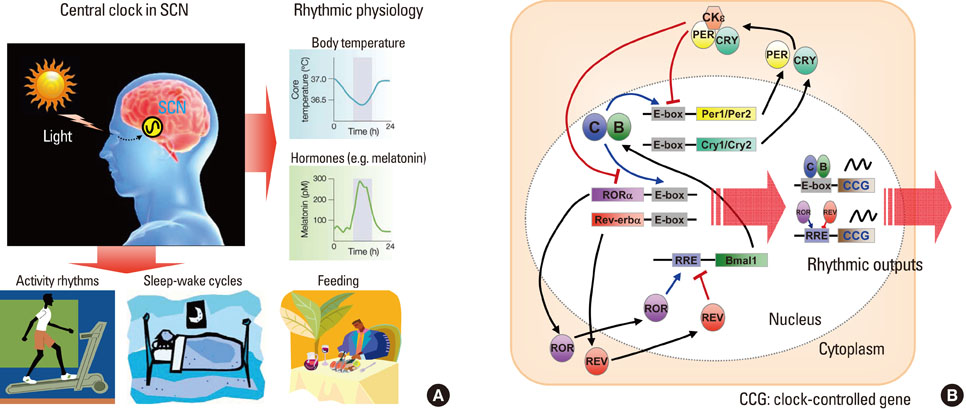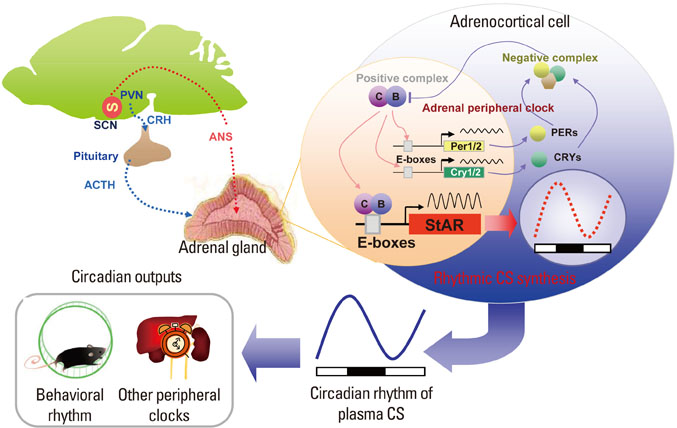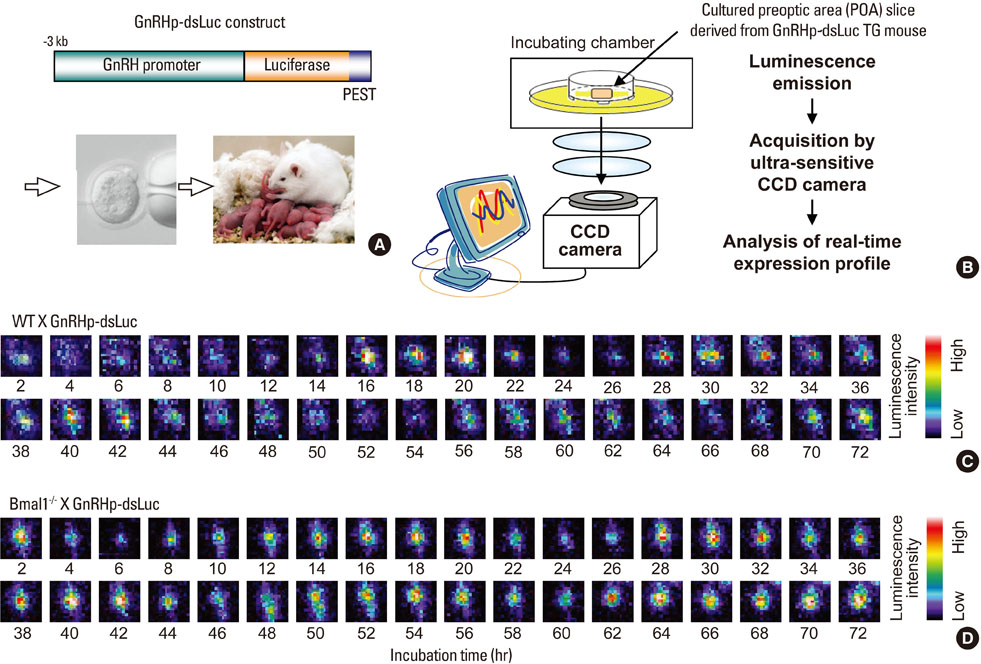Endocrinol Metab.
2010 Dec;25(4):249-257. 10.3803/EnM.2010.25.4.249.
Biological Rhythms and Neuroendocrine Systems
- Affiliations
-
- 1Department of Biological Sciences, College of Natural Sciences, Seoul National University, and Brain Research Center for the 21st Century Frontier Program in Neuroscience, MEST, Seoul, Korea. kyungjin@snu.ac.kr
- KMID: 1497749
- DOI: http://doi.org/10.3803/EnM.2010.25.4.249
Abstract
- No abstract available.
MeSH Terms
Figure
Reference
-
1. Stratmann M, Schibler U. Properties, entrainment and physiological functions of mammalian peripheral oscillators. J Biol Rhythms. 2006. 21:494–506.2. Ko CH, Takahashi JS. Molecular components of the mammalian circadian clock. Hum Mol Genet. 2006. 15:R271–R277.3. Gallego M, Virshup DM. Post-translational modifications regulate the ticking of the circadian clock. Nat Rev Mol Cell Biol. 2007. 8:139–148.4. Jung H, Choe Y, Kim H, Park N, Son GH, Khang I, Kim K. Involvement of CLOCK:BMAL1 heterodimer in serum-responsive mPer1 induction. Neuroreport. 2003. 14:15–19.5. Shim HS, Kim H, Lee J, Son GH, Cho S, Oh TH, Kang SH, Seen DS, Lee KH, Kim K. Rapid activation of CLOCK by Ca2+-dependent protein kinase C mediates resetting of the mammalian circadian clock. EMBO Rep. 2007. 8:366–371.6. Lee Y, Lee J, Kwon I, Nakajima Y, Ohmiya Y, Son GH, Lee KH, Kim K. Coactivation of the CLOCK-BMAL1 complex by CBP mediates resetting of the circadian clock. J Cell Sci. 2010. 123:3547–3557.7. Kwon I, Lee J, Chang SH, Jung NC, Lee BJ, Son GH, Kim K, Lee KH. BMAL1 shuttling controls transactivation and degradation of the CLOCK/BMAL1 heterodimer. Mol Cell Biol. 2006. 26:7318–7330.8. Lee J, Lee Y, Lee MJ, Park E, Kang SH, Chung CH, Lee KH, Kim K. Dual modification of BMAL1 by SUMO2/3 and ubiquitin promotes circadian activation of the CLOCK/BMAL1 complex. Mol Cell Biol. 2008. 28:6056–6065.9. Balsalobre A, Damiola F, Schibler U. A serum shock induces circadian gene expression in mammalian tissue culture cells. Cell. 1998. 93:929–937.10. Chrousos GP, Kino T. Glucocorticoid action networks and complex psychiatric and/or somatic disorders. Stress. 2007. 10:213–219.11. Stocco DM. The role of the StAR protein in steroidogenesis: challenges for the future. J Endocrinol. 2000. 164:247–253.12. Oster H, Damerow S, Kiessling S, Jakubcakova V, Abraham D, Tian J, Hoffmann MW, Eichele G. The circadian rhythm of glucocorticoids is regulated by a gating mechanism residing in the adrenal cortical clock. Cell Metab. 2006. 4:163–173.13. Son GH, Chung S, Choe HK, Kim HD, Baik SM, Lee H, Lee HW, Choi S, Sun W, Kim H, Cho S, Lee KH, Kim K. Adrenal peripheral clock controls the autonomous circadian rhythm of glucocorticoid by causing rhythmic steroid production. Proc Natl Acad Sci U S A. 2008. 105:20970–20975.14. Meier AH. Daily variation in concentration of plasma corticosteroid in hypophysectomized rats. Endocrinology. 1976. 98:1475–1479.15. Andrews RV, Folk GE Jr. Circadian metabolic patterns in cultured hamster adrenal glands. Comp Biochem Physiol. 1964. 11:393–409.16. Ishida A, Mutoh T, Ueyama T, Bando H, Masubuchi S, Nakahara D, Tsujimoto G, Okamura H. Light activates the adrenal gland: timing of gene expression and glucocorticoid release. Cell Metab. 2005. 2:297–307.17. Ulrich-Lai YM, Arnhold MM, Engeland WC. Adrenal splanchnic innervation contributes to the diurnal rhythm of plasma corticosterone in rats by modulating adrenal sensitivity to ACTH. Am J Physiol Regul Integr Comp Physiol. 2006. 290:R1128–R1135.18. Koyanagi S, Okazawa S, Kuramoto Y, Ushijima K, Shimeno H, Soeda S, Okamura H, Ohdo S. Chronic treatment with prednisolone represses the circadian oscillation of clock gene expression in mouse peripheral tissues. Mol Endocrinol. 2006. 20:573–583.19. Oishi K, Amagai N, Shirai H, Kadota K, Ohkura N, Ishida N. Genomewide expression analysis reveals 100 adrenal gland-dependent circadian genes in the mouse liver. DNA Res. 2005. 12:191–202.20. Carroll T, Raff H, Findling JW. Late-night salivary cortisol measurement in the diagnosis of Cushing's syndrome. Nat Clin Pract Endocrinol Metab. 2008. 4:344–350.21. Cleare AJ. The neuroendocrinology of chronic fatigue syndrome. Endocr Rev. 2003. 24:236–252.22. Gan EH, Quinton R. Physiological significance of the rhythmic secretion of hypothalamic and pituitary hormones. Prog Brain Res. 2010. 181:111–126.23. Knobil E. Remembrance: the discovery of the hypothalamic gonadotropin-releasing hormone pulse generator and of its physiological significance. Endocrinology. 1992. 131:1005–1006.24. Moenter SM, DeFazio AR, Pitts GR, Nunemaker CS. Mechanisms underlying episodic gonadotropin-releasing hormone secretion. Front Neuroendocrinol. 2003. 24:79–93.25. Nuñez L, Faught WJ, Frawley LS. Episodic gonadotropin-releasing hormone gene expression revealed by dynamic monitoring of luciferase reporter activity in single, living neurons. Proc Natl Acad Sci U S A. 1998. 95:9648–9653.26. Vazquez-Martinez R, Shorte SL, Faught WJ, Leaumont DC, Frawley LS, Boockfor FR. Pulsatile exocytosis is functionally associated with GnRH gene expression in immortalized GnRH-expressing cells. Endocrinology. 2001. 142:5364–5370.27. Keen KL, Wegner FH, Bloom SR, Ghatei MA, Terasawa E. An increase in kisspeptin-54 release occurs with the pubertal increase in luteinizing hormone-releasing hormone-1 release in the stalk-median eminence of female rhesus monkeys in vivo. Endocrinology. 2008. 149:4151–4157.





